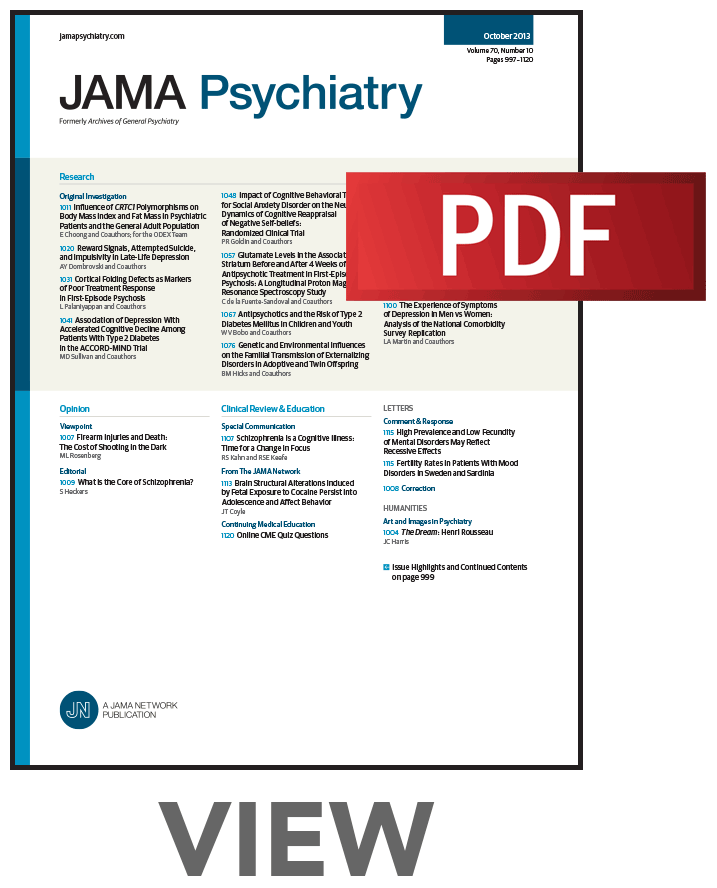神经精神疾病视网膜细胞类型的遗传分析
IF 22.5
1区 医学
Q1 PSYCHIATRY
引用次数: 0
摘要
作为中枢神经系统的一个可接近的部分,视网膜为研究人类大脑疾病的病理生理机制提供了一个独特的窗口。成像和电生理学研究已经揭示了几种神经精神和神经疾病的视网膜改变,但仍不清楚具体是哪种细胞类型和生物学机制参与其中。目的确定特定的视网膜细胞类型是否受到神经精神和神经疾病基因组风险的影响,并探讨基因组风险在这些细胞类型中聚集的机制。设计、环境和参与者:这项遗传关联研究结合了精神分裂症、双相情感障碍、重度抑郁症、多发性硬化症、帕金森病、阿尔茨海默病和中风的全基因组关联研究结果,以及来自人类、猕猴和小鼠的视网膜单细胞转录组数据集。为了鉴定易感细胞类型,应用了基因组注释的多标记分析(MAGMA)细胞类型富集分析和随后的途径分析。利用视网膜光学相干断层扫描(2009年至2010年间获得)和基于英国生物银行的大型人群队列研究的基因分型数据,将细胞顶部命中转化为结构水平。数据分析是在2022年至2024年间进行的。视网膜细胞基因表达谱中神经精神和神经疾病特征遗传风险负荷的细胞类型特异性富集。结果在不同哺乳动物物种和不同发育阶段,无突细胞(视网膜内的中间神经元)的表达谱在精神分裂症遗传风险中显著富集。这种富集主要是由参与突触生物学的基因驱动的。此外,视网膜免疫细胞群的表达谱在多发性硬化症遗传风险中丰富。双相情感障碍、重度抑郁症、帕金森病、阿尔茨海默病或中风没有发现一致的细胞类型关联。在结构水平上,较高的精神分裂症多基因风险与神经节细胞内丛状层变薄有关,其中包含无突细胞的树突和突触连接(B,−0.09;95% CI,−0.16 ~−0.03;P = .007;N = 36 349;平均[SD]年龄57.50[8.00]岁;19 859名女性[54.63%])。多发性硬化症的高多基因风险与视网膜神经纤维层厚度增加有关(B, 0.06;95% CI, 0.02 ~ 0.10;P = .007;N = 36 371;平均[SD]年龄57.51[8.00]岁;女性19 843人[54.56%])。结论和相关性本研究为神经精神和神经疾病视网膜改变的细胞基础提供了新的见解,并强调了视网膜作为研究精神分裂症突触病理的潜在代理。本文章由计算机程序翻译,如有差异,请以英文原文为准。
Genetic Analysis of Retinal Cell Types in Neuropsychiatric Disorders
ImportanceAs an accessible part of the central nervous system, the retina provides a unique window to study pathophysiological mechanisms of brain disorders in humans. Imaging and electrophysiological studies have revealed retinal alterations across several neuropsychiatric and neurological disorders, but it remains largely unclear which specific cell types and biological mechanisms are involved.ObjectiveTo determine whether specific retinal cell types are affected by genomic risk for neuropsychiatric and neurological disorders and to explore the mechanisms through which genomic risk converges in these cell types.Design, Setting, and ParticipantsThis genetic association study combined findings from genome-wide association studies in schizophrenia, bipolar disorder, major depressive disorder, multiple sclerosis, Parkinson disease, Alzheimer disease, and stroke with retinal single-cell transcriptomic datasets from humans, macaques, and mice. To identify susceptible cell types, Multi-Marker Analysis of Genomic Annotation (MAGMA) cell-type enrichment analyses were applied and subsequent pathway analyses performed. The cellular top hits were translated to the structural level using retinal optical coherence tomography (acquired between 2009 and 2010) and genotyping data in the large population-based UK Biobank cohort study. Data analysis was conducted between 2022 and 2024.Main Outcomes and MeasuresCell type–specific enrichment of genetic risk loading for neuropsychiatric and neurological disorder traits in the gene expression profiles of retinal cells.ResultsExpression profiles of amacrine cells (interneurons within the retina) were robustly enriched in schizophrenia genetic risk across mammalian species and in different developmental stages. This enrichment was primarily driven by genes involved in synapse biology. Moreover, expression profiles of retinal immune cell populations were enriched in multiple sclerosis genetic risk. No consistent cell-type associations were found for bipolar disorder, major depressive disorder, Parkinson disease, Alzheimer disease, or stroke. On the structural level, higher polygenic risk for schizophrenia was associated with thinning of the ganglion cell inner plexiform layer, which contains dendrites and synaptic connections of amacrine cells (B, −0.09; 95% CI, −0.16 to −0.03; P = .007; n = 36 349; mean [SD] age, 57.50 [8.00] years; 19 859 female [54.63%]). Higher polygenic risk for multiple sclerosis was associated with increased thickness of the retinal nerve fiber layer (B, 0.06; 95% CI, 0.02 to 0.10; P = .007; n = 36 371; mean [SD] age, 57.51 [8.00] years; 19 843 female [54.56%]).Conclusions and RelevanceThis study provides novel insights into the cellular underpinnings of retinal alterations in neuropsychiatric and neurological disorders and highlights the retina as a potential proxy to study synaptic pathology in schizophrenia.
求助全文
通过发布文献求助,成功后即可免费获取论文全文。
去求助
来源期刊

JAMA Psychiatry
PSYCHIATRY-
CiteScore
30.60
自引率
1.90%
发文量
233
期刊介绍:
JAMA Psychiatry is a global, peer-reviewed journal catering to clinicians, scholars, and research scientists in psychiatry, mental health, behavioral science, and related fields. The Archives of Neurology & Psychiatry originated in 1919, splitting into two journals in 1959: Archives of Neurology and Archives of General Psychiatry. In 2013, these evolved into JAMA Neurology and JAMA Psychiatry, respectively. JAMA Psychiatry is affiliated with the JAMA Network, a group of peer-reviewed medical and specialty publications.
 求助内容:
求助内容: 应助结果提醒方式:
应助结果提醒方式:


